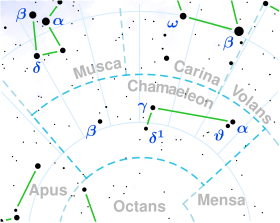Astronomy:HD 114533
| Observation data Epoch J2000.0 Equinox (celestial coordinates) | |
|---|---|
| Constellation | Chamaeleon |
| Right ascension | 13h 14m 17.3297s[1] |
| Declination | −78° 26′ 50.8362″[1] |
| Apparent magnitude (V) | 5.84±0.01[2] |
| Characteristics | |
| Spectral type | G2 Ib[3] |
| U−B color index | +0.72[4] |
| B−V color index | +1.07[4] |
| Astrometry | |
| Radial velocity (Rv) | −17.9±0.3[5] km/s |
| Proper motion (μ) | RA: −9.435[1] mas/yr Dec.: −4.222[1] mas/yr |
| Parallax (π) | 1.5528 ± 0.0359[1] mas |
| Distance | 2,100 ± 50 ly (640 ± 10 pc) |
| Absolute magnitude (MV) | −2.0[6] |
| Details | |
| Mass | 3.78[7] M☉ |
| Radius | 77.3±4.0[8] R☉ |
| Luminosity | 2,383±110[9] L☉ |
| Surface gravity (log g) | 1.21[7] cgs |
| Temperature | 4,514+372−274[10] K |
| Metallicity [Fe/H] | −0.04+0.01−0.00[1] dex |
| Rotational velocity (v sin i) | 9.2±1[11] km/s |
| Other designations | |
| Database references | |
| SIMBAD | data |
HD 114533, also known as HR 4976, is a solitary star located in the southern circumpolar constellation Chamaeleon. It has an apparent magnitude of 5.84, making it faintly visible to the naked eye. The system is located relatively far at a distance of roughly 2,100 light years based on Gaia DR3 parallax measurements but is drifting closer with a heliocentric radial velocity of −18 km/s. At its current distance, HD 114533A's brightness is diminished by 0.74 magnitudes due to interstellar dust.[13] It has an absolute magnitude of −2.0.[6]
This is an evolved supergiant with a stellar classification of G2 Ib.[3] It has also been given class of F8 Ib,[14] indicating a slightly hotter star. It has 3.78 times the mass of the Sun[7] but has expanded to 77.3 times its girth.[8] HD 114533 radiates over 2,000 times the bolometric luminosity[9] of the Sun from its enlarged photosphere at an effective temperature of 4,514 K,[10] giving it a yellowish-orange hue. The object has a near-solar metallicity[1] and spins modestly with a projected rotational velocity of 9.2 km/s.[11]
References
- ↑ Jump up to: 1.0 1.1 1.2 1.3 1.4 1.5 1.6 Vallenari, A. et al. (2022). "Gaia Data Release 3. Summary of the content and survey properties". Astronomy & Astrophysics. doi:10.1051/0004-6361/202243940 Gaia DR3 record for this source at VizieR.
- ↑ Høg, E.; Fabricius, C.; Makarov, V. V.; Urban, S.; Corbin, T.; Wycoff, G.; Bastian, U.; Schwekendiek, P. et al. (March 2000). "The Tycho-2 catalogue of the 2.5 million brightest stars". Astronomy and Astrophysics 355: L27–L30. ISSN 0004-6361. Bibcode: 2000A&A...355L..27H.
- ↑ Jump up to: 3.0 3.1 Houk, N.; Cowley, A. P. (1975). University of Michigan Catalogue of two-dimensional spectral types for the HD stars. Volume I. Declinations −90° to −53°. Bibcode: 1975mcts.book.....H.
- ↑ Jump up to: 4.0 4.1 Johnson, H. L.; Mitchell, R. I.; Iriarte, B.; Wisniewski, W. Z. (1966). "UBVRIJKL Photometry of the Bright Stars". Communications of the Lunar and Planetary Laboratory 4: 99–110. Bibcode: 1966CoLPL...4...99J.
- ↑ Gontcharov, G. A. (November 2006). "Pulkovo Compilation of Radial Velocities for 35 495 Hipparcos stars in a common system". Astronomy Letters 32 (11): 759–771. doi:10.1134/S1063773706110065. ISSN 1063-7737. Bibcode: 2006AstL...32..759G.
- ↑ Jump up to: 6.0 6.1 Anderson, E.; Francis, Ch. (May 2012). "XHIP: An extended hipparcos compilation". Astronomy Letters 38 (5): 331–346. doi:10.1134/S1063773712050015. ISSN 1063-7737. Bibcode: 2012AstL...38..331A.
- ↑ Jump up to: 7.0 7.1 7.2 Anders, F. et al. (August 2019). "Photo-astrometric distances, extinctions, and astrophysical parameters for Gaia DR2 stars brighter than G = 18". Astronomy & Astrophysics 628: A94. doi:10.1051/0004-6361/201935765. ISSN 0004-6361. Bibcode: 2019A&A...628A..94A.
- ↑ Jump up to: 8.0 8.1 Kervella, P.; Thévenin, F.; Di Folco, E.; Ségransan, D. (October 2004). "The angular sizes of dwarf stars and subgiants". Astronomy & Astrophysics 426 (1): 297–307. doi:10.1051/0004-6361:20035930. ISSN 0004-6361. Bibcode: 2004A&A...426..297K.
- ↑ Jump up to: 9.0 9.1 Brown, A. G. A. (August 2018). "Gaia Data Release 2: Summary of the contents and survey properties". Astronomy & Astrophysics 616: A1. doi:10.1051/0004-6361/201833051. Bibcode: 2018A&A...616A...1G. Gaia DR2 record for this source at VizieR.
- ↑ Jump up to: 10.0 10.1 Ammons, S. Mark; Robinson, Sarah E.; Strader, Jay; Laughlin, Gregory; Fischer, Debra; Wolf, Aaron (20 February 2006). "The N2K Consortium. IV. New Temperatures and Metallicities for More than 100,000 FGK Dwarfs". The Astrophysical Journal 638 (2): 1004–1017. doi:10.1086/498490. ISSN 0004-637X. Bibcode: 2006ApJ...638.1004A.
- ↑ Jump up to: 11.0 11.1 De Medeiros, J. R.; Udry, S.; Burki, G.; Mayor, M. (29 October 2002). "A catalog of rotational and radial velocities for evolved stars". Astronomy & Astrophysics 395 (1): 97–98. doi:10.1051/0004-6361:20021214. ISSN 0004-6361. Bibcode: 2002A&A...395...97D.
- ↑ "HD 114533". SIMBAD. Centre de données astronomiques de Strasbourg. http://simbad.u-strasbg.fr/simbad/sim-basic?Ident=HD+114533.
- ↑ Guarinos, J. (February 1995). "VizieR Online Data Catalog: Interstellar matter in the Galactic Disk (Guarinos J., 1992)". VizieR Online Data Catalog: 301V/86. Bibcode: 1995yCat.5086....0G.
- ↑ Malaroda, S. (August 1975). "Study of the F-type 1 MK spectral types.". The Astronomical Journal 80: 637. doi:10.1086/111786. ISSN 0004-6256. Bibcode: 1975AJ.....80..637M.
<ref> tag with name "Gould1879" defined in <references> is not used in prior text.
 |


